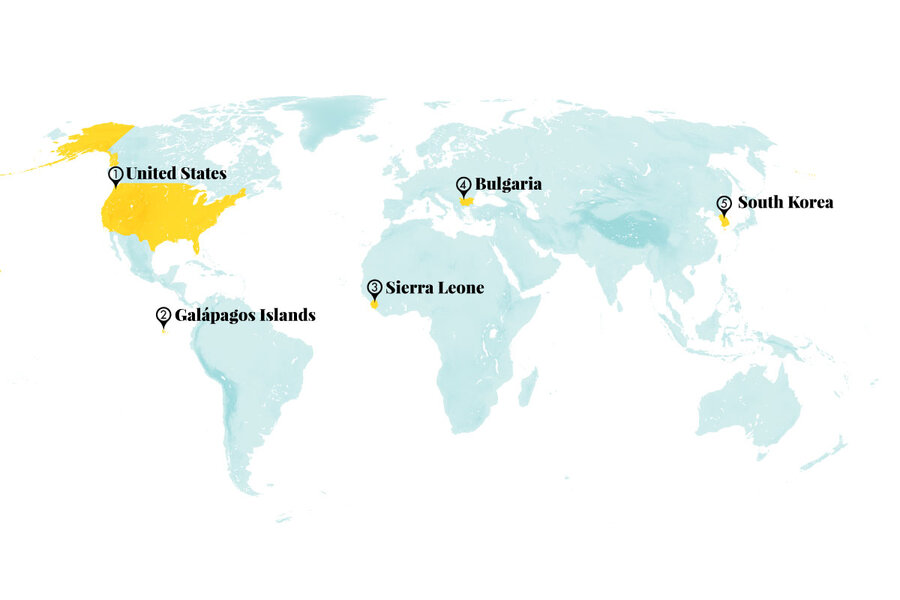From coffee to vultures, preserving forgotten species
Loading...
Breakthroughs this week include physicists who achieved the highest intensity laser ever, and chemical engineers who catalyzed jet fuel from plastic waste.
1. United States
Researchers from Washington State University have developed a cost-effective process to convert plastic into jet fuel, paving the way for large-scale chemical recycling. Plastic pollution is a growing problem, but recycling initiatives are often stymied by a lack of financial incentives. Most mechanically recycled plastics are melted down and reshaped into a new product, with some degradation in quality. Chemical recycling creates higher-quality products, but has been too expensive and time-consuming to bring to scale.
Why We Wrote This
Sometimes progress requires a look back in time, even in science. This week’s roundup includes botanists’ rediscovery of an old type of coffee whose cultivation may help with climate resilience.
In the journal Chem Catalysis, the WSU team explains that it was able to turn 90% of polyethylene into jet fuel at a relatively low 428 degrees Fahrenheit, within 60 minutes. The method, scientists say, is designed to upcycle the plastic causing the most pollution and to model financially viable recycling technology. They’re now working to scale the catalytic process and experiment with other types of plastic waste.
Interesting Engineering
2. Galápagos Islands
A coalition of more than 40 organizations is putting $43 million toward restoring Galapágos island habitats. Ecuador’s famous archipelago is a biodiversity hot spot, known for its many endemic species. The initiative’s priorities are reversing degradation on Floreana Island, as well as protecting the area’s marine reserves and helping boost populations of the critically endangered pink land iguana. Partners include local governments, nongovernmental organizations, and others. One of the effort leaders, a global ecosystem restoration group recently rebranded as Re:wild, is backed by actor and environmentalist Leonardo DiCaprio.
“Time is running out for so many species, especially on islands where their small populations are vulnerable and threatened,” said Paula A. Castaño, a veterinarian and island restoration specialist living on the Galapágos. “We know how to prevent these extinctions and restore functional and thriving ecosystems – we have done it – but we need to replicate these successes, innovate and go to scale.”
Mongabay
3. Sierra Leone
The rediscovery of a long-lost, heat-resistant coffee species is offering hope for an industry struggling with the effects of climate change. Not seen in the wild since the 1980s, Coffea stenophylla has demonstrated a high heat tolerance and strong flavor profile, similar to standard-bearing arabica, which makes up 56% of global coffee production. (Robusta, a cheaper species largely used in instant coffee, represents 43%.) A group of scientists led by botanist Aaron Davis located a healthy population of C. stenophylla in southeastern Sierra Leone in 2018, and recently confirmed its viability as a hearty arabica alternative in a study published by Nature Plants.
Alternatives like this are needed – some researchers expect global arabica production to fall 50% over the next few decades due to climate change. “Stenophylla provides us with an important resource for breeding a new generation of climate-resilient coffee crop plants,” said Dr. Davis.
Reuters, Nature Plants
4. Bulgaria
Bulgaria now has a stable population of around 80 griffon vultures, more than four decades after the birds were considered extinct in the Balkan nation. Among the population are roughly 23 to 25 breeding pairs, according to a new report. Scavenger species play a critical role in maintaining healthy ecosystems, but the griffon vulture was considered missing from Bulgaria until 1978, when scientists discovered a colony in the Eastern Rhodopes Mountains.
Now, after a decadelong restoration effort by the Fund for Wild Flora and Fauna, Green Balkans, and the Birds of Prey Protection Society, they’re reclaiming their historical breeding range. It’s not an entirely smooth transition, say researchers, with about a third of one site’s released vultures getting electrocuted by nearby power lines. Still, other signs show the species is adjusting well – 80% are relying on animal carcasses found in the field, rather than on conservationist-operated feeding stations, and vultures have been reproducing in the wild since 2016. The griffon vultures’ continued success in the region also offers hope for the cinereous and bearded vultures, both of which are native to Bulgaria but are now found only in Asia.
Earther, Biodiversity Data Journal
5. South Korea
A research team at the Institute for Basic Science in Seoul has created the world’s highest-intensity laser, opening up new opportunities to understand the cosmos. Intensity depends on two factors: high power output, focused onto a tiny space. At 1023 watts per centimeters squared, IBS physicists have achieved the equivalent of directing all the Earth’s sunlight onto an area many times smaller than the diameter of a human hair.The previous record, set by scientists from the University of Michigan in 2004, was 1022 W/cm2.
The research team used a set of deformable mirrors – similar to those used in astronomy – and a large off-axis parabolic mirror to fine-tune their pulsed laser system. “With the highest laser intensity achieved ever, we can tackle new challenging areas of experimental science,” said Nam Chang-hee, director of the Center for Relativistic Laser Science and leader of the study. “This kind of research is directly related to various astrophysical phenomena occurring in the universe and can help us to further expand our knowledge horizon.”
Aju Business Daily, Cosmos
World
A startup is using wood waste to 3D-print architectural accents and consumer goods that mimic the properties of natural wood. Wood manufacturers generate millions of tons of sawdust each year, much of which is burned or landfilled. Forust’s technology deposits a binding agent made with lignin – the organic polymer byproduct of the paper industry – over thin layers of sawdust to create intricate designs, one layer at a time.
Unlike particle board, another wood substitute that uses sawdust, Forust’s pieces print a realistic grain running throughout, so they can be sanded and stained like natural wood. This also makes 3D-printed wood a possible alternative for the luxury trade, which has made some highly trafficked tree species vulnerable to overexploitation. Forust is currently working on its first collection with designer Yves Béhar’s Fuseproject.
Fast Company, 3D Printing Media Network








